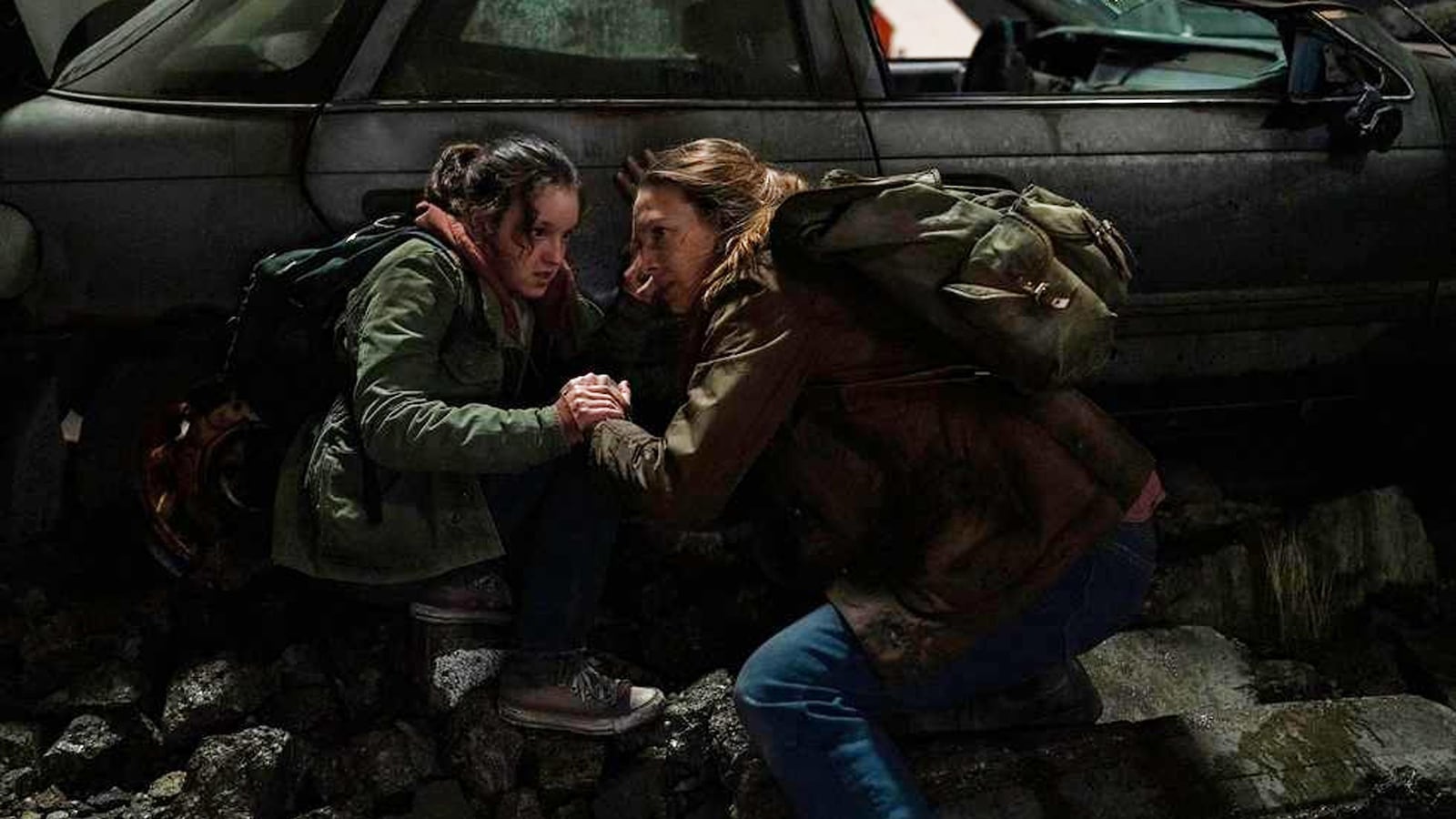Okay, first thing, first. Do you have tissues handy? Go get some. You are going to need a plethora for this episode.
Now that my warning is out of the way (and I will probably have this same warning for every episode), let's dig into the first episode of HBO’s The Last of Us. From the show’s opening frames, it’s clear that the new drama will chart a slightly different course from the acclaimed video game series it is based on.
(Warning: Spoilers ahead for The Last of Us.)
The premiere episode opens in 1968—many years before the cordyceps pandemic hits and devastates the world—with doctors discussing the terrifying possibilities of global pandemics. (Currently going through a global viral pandemic really makes this all the more fun!) One doctor pipes up that the concern over what the next pandemic will be is less viral and bacterial, but fungal. He proceeds to go into horrifying detail of just how a fungal pandemic could happen, which leaves the audience and the host of the talk show these two doctors are on in stunned silence.
Cut to Texas on Sept. 26, 2003. This, we learn, is Outbreak Day, the day that the fungal pandemic comes to fruition. (There is one slight change here already in the story: In the game, Outbreak Day was in 2013.) We meet Joel Miller (Pedro Pascal) and his daughter Sarah (Nico Parker, the spitting image of her mother Thandiwe Newton) on a typical morning. Sarah is cooking breakfast for her father as a birthday treat, while he scrambles to get ready for work; all seems well and right with the world. However, little signs of trouble lurk around every corner—there are people who begin randomly twitching, cop cars are racing by, and shops are closing early with urgency.

It’s at night when things really take a turn. For those who have played the game, this will all be very familiar, albeit for a few changes. Sarah gives Joel his birthday gift—his fixed watch (this is important)—and the two fall asleep while watching a movie. Sarah later awakens from the sound of explosions and helicopters flying overhead. Things have gone from strange to apocalyptic.
As Sarah searches for her father—he went to bail his brother Tommy (Gabriel Luna) out of jail—she winds up in her neighbors home. There, she finds them feasted upon by a family member who has become an Infected, a person whose body is now under control by the now-sentient fungi biting people around the country. (You may remember her as the old woman twitching earlier in the episode.) Luckily, Joel and Tommy arrive just in time to kill the woman chasing after Sarah.
After finally being reunited, Joel and Tommy take Sarah and head for the highway and out of town. Unfortunately, everyone else has the same idea. The trio soon find themselves heading into a very crowded and very infected downtown. People are scrambling out of establishments as others are being bitten and eaten in the streets.
And just when you think things can’t get any worse, a plane exploding in the street causes Tommy’s car to crash and leaves Sarah with a broken ankle. Now, it’s up to Joel to carry her out of danger. There is a level of fear during this moment that you can only get from being at the helm of a character, like in the video game. However, this adaptation comes pretty darn close to recreating that sense of dread.
Joel and Sarah finally reach a point of safety, after a soldier shoots a particularly quick and hungry Infected tailing them. However, the relief is short-lived when Joel realizes that the soldier has also been given orders to shoot him and Sarah. Joel does his best to plead with him, but he opens fires, sending Sarah and Joel flying off in different directions.
Tommy, who got separated in the crash, arrives just in time to kill the soldier before the soldier can finish off Joel, but sadly, the damage is done. Sarah has been shot in the stomach and dies in Joel’s arms. The moment, also a devastating one in the game, is made all the more emotional, thanks to stunning and gut-wrenching performances from both Pascal and Parker.
As my friend said to me when I got to this soul-crushing scene in the video game, “Welcome to The Last of Us.” Humans being more dangerous than the Infected ever could be is pretty much a running theme in this story, so take note. And just like I expected, the show’s recreation of the first 15 minutes of the game did break me.
At this point, the episode time jumps once more. Now it is 20 years later (2023) in post-outbreak Boston. Quarantine zones (QZs) are set up by FEDRA (military/government, basically) to keep the uninfected safe and the Infected out. Major cities have been bombed to smithereens, in an effort to kill as many Infected as possible. Basically, it is a dystopian hell. Public hangings are back in fashion, and there are burn pits for all the bodies—it doesn’t get more grim than that. Observing this horrifying setting is the first (of many) indications that FEDRA is not exactly good.
There is one main group fighting against FEDRA, however, and that is the Fireflies. This is a group of people who have left their QZs, and they have been ramping up their attacks on the QZ in recent days, in the hopes of liberating Boston from FEDRA. But more on them later. First, we need to catch up with Joel.
Like most people in the QZs, Joel does many odd jobs that earn him ration cards for food and other necessities, but he also is a smuggler. He works with his lover—Joel won’t define the relationship, but I sure as hell will—Tess (Anna Torv) to bring illegal goods in and out of the QZ. However, they both get screwed over when Robert (Brendan Fletcher) sells the car battery they need to the Fireflies. Joel and Tess need these supplies to help them find Tommy, who they haven’t heard from in three weeks. Enter the Fireflies and the Queen Firefly herself: Marlene (Merle Dandridge, reprising the role she played in the video game).
Marlene promises Joel and Tess all the guns and ammo they need, along with a car battery if they can smuggle something out of the QZ and to the old state house. That “something?” A 14-year old girl named Ellie (Bella Ramsey).
We met Ellie earlier on in the episode, in the Fireflies headquarters. She’s the kid that tells guards that her name is Veronica and then flips them off. In terms of character introductions, Ellie calling all the guards “motherfuckers” is very on brand. Special shout-out to Ellie asking Marlene if she was her “fucking mom or something.” Sometimes The Last of Us can really give you a good laugh. Between sobs, of course.
Joel and Tess reluctantly agree to the terms and set forth on smuggling the teenager out. However, when they run across FEDRA on their escape, they find out some knowledge that changes things: Ellie is infected with the fungus. Yes, the reason Ellie was held by the Fireflies was because she was bitten but hasn’t yet turned into an Infected. The first stage of the fungal infection will turn you into a runner, basically meaning you are no longer yourself and you are very interested in biting and infecting other people. The longer you are infected, the more you look like a mushroom head.
At the end of this recap, I have written out a guide to all the infected types from the Last of Us world for you all to come back to (enjoy!). Anywho, it turns out that she is immune to all that.
After this almost-deadly interaction with FEDRA, Joel, Tess, and Ellie make it out of the QZ alive but bruised. Their journey to the state house is only just beginning, and by the sounds of the Infected screaming… it’s going to be perilous.
The ground this entire episode covers can take several hours to play in the video game, so the fact that Craig Mazin and Neil Druckmann condensed this whole part into a 90-minute premiere without sacrificing any emotions is impressive. No one has yet had to move a dumpster over in order to climb up a fire escape, which is a bummer, but there are eight episodes to go, so there’s plenty of time for that.
And with that, The Last of Us’ first season is going to be a long and emotional ride, so strap in. After all, we haven’t even met a Clicker yet…
A QUICK GUIDE TO THE TYPES OF INFECTED IN THE LAST OF US
Runners: These are predominantly the types of Infected you see in the show. They can see and when they spot you they come running, hence the name. They are freshly infected by the virusand easier to kill.
Threat level: You can take ‘em.
Stalkers: We haven’t come across these nasty buggers yet, but they are annoying and deadly. They are very quiet, and sometimes they are stuck to walls and like to pop out at you when you least expect it. Always a good time. They are a bit harder to kill than runners but not that much more.
Threat level: Ugh, meh.
Clickers: These you will meet soon, unfortunately. They have been infected longer than runners and they use clicking and screeching to find their location. They are blind but thanks to fungus plates on their skull they have great echolocation. They are fast, aggressive, tough to kill, and very deadly.
Threat level: You better run.
Bloaters: If you thought clickers were bad, just you wait! Bloaters have been infected much longer than clickers and even more deadly and hard to kill. Like clickers they are blind and also use echolocation to find you. Luckily, they move a bit slow, so running is your best friend. In the video game, they also like to throw fungus spores at you. You know, just to make it a bit more challenging!
Threat level: GET OUT OF THERE!
Shamblers: These didn’t come in until the second Last of Us game, but just to be thorough here, I will explain. They are the worst. They can run towards you very fast and all shambly, hence the name. They spray acid and they really love to just rip you apart.
Threat level: AH! Fuck this.







